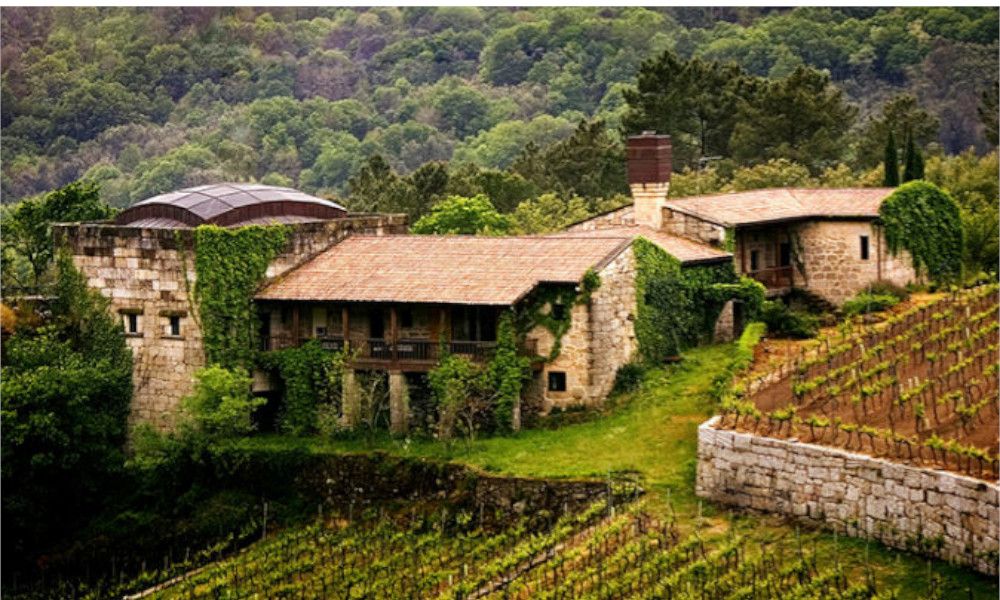Treixadura
Viña Mein is the personal project of Javier Alen, pioneer of the Ribeiro region. Since 2014, he has had the help of the young wolves of Comando G, who are turning the entire domain towards biodynamics and going for a fresher, minerally style. Without a doubt the best of the Treixadura!
History of Viña Mein
The Ribeiro appellation is Galicia's oldest appellation. The green province of Ourense has a long history in viticulture. As early as the 12th century, Ribeiro wines were known all over Spain. The Treixadura grape in particular played a major role in this.
Javier Alen, owner of Viña Mein, is without a doubt the pioneer of the Treixadura revival. As a little boy, Javier spent up to his 6 years in Leiro, a small village near the monastery of San Clodio. His parents then moved to Madrid, but the memory of his native region was revived every summer as the family moved to the ancestral home in Leiro for three months. Javier was a lawyer in Madrid for more than 15 years, but eventually turned his life around: he founded a bookstore in Madrid specializing in travel literature and in 1987 he returned to Leiro to become a winegrower there. He completely restored Viña Mein's old Pazo into a beautiful hotel and a small wine estate.
Today, Viña Mein is the leader of the new white wines from Ribeiro. The Treixadura in coupage with other typical grape varieties guarantees fresh and mineral white wines. A small amount of red wines are also made with the typical grape varieties. Since the beginning of 2019, Viña Mein has belonged to the Pago de Carreavojas group, which in addition to the famous ribera wines from Carrraovejas also includes Emilio Rooja and Ossian.
Varieties
Treixadura is the main grape. It ripens slowly and cannot withstand planting at a great height. The skin is coarse and hard (hence its name). The acidity is perfect, full of floral aromas and notes of fruit. The Treixadura is complemented in its coupage with other grape varieties, some of which can also be found in other Galician regions. About 12 ha has been planted in Viña Mein.
Godello (1.8 ha) is the grape best suited for high altitude ripening. This grape has a short cycle and produces small grapes, a variety that thrives on the slopes of the valley.
Albariño (0.5 ha) is very limited. This grape gives strength and at the same time finesse to the wines. In addition, this grape can combine high alcohol contents with a lot of acidity, which is exceptional.
Torrontés (0.6 ha) is an old variety that used to be widespread across Spain. This grape gives freshness and a slightly bitter aftertaste. Torrontés is rather light in texture, which makes the cut of a grape with a lot of structure such as Lado perfect.
Lado (0.2 ha) is a grape of clearly Atlantic origin, which has become very rare. This grape has the perfect capacity to combine high alcohol contents with high acidity (such as Albariño), aromatic, but less fine and exotic than the Albariño.
Loureira (0.8 ha) is a variety whose roots are hard to find and which is very different from many other typical Atlantic grape varieties. Nevertheless, Loureira was traditionally planted in Ribeiro. Nevertheless, this grape is not immediately suitable for monovarietal wines, due to very low alcohol contents, many bitters and high acidity. The grape was mainly planted because of its high aromatic potential with a lot of complexity; its name also refers to it (Loureira is Galician for laurel). Hence, a small amount in a cut can be of great benefit. From this grape variety also comes the beautiful spiciness that we find in the Viña Mein.
Finally, Albilla (0.2 ha) is a minor grape that mainly applies glycerol in the cut with delicate aromas of honey.
Terroir
Typical Galician granite soil with a shallow vegetation layer on top of between 70 to 100 cm, often with very little organic matter. The top layer mainly consists of 'sábrego', a mixture of clay and sand consisting of granite grains. The result of millions of years of erosion of the large 'bolos' or giant boulders. The bodega is built against one such bolos: a giant boulder more than 5 m high.
The location in the valley ensures that there is a big difference between day and night, often up to 20 ° C, which ensures that the grapes ripen perfectly and slowly, so that there is more aroma and concentration. There is quite a lot of sun and little rainfall by Galician standards. Quite a lot of thunderstorms at the end of the summer and freezing cold during the winter. There are also many days with fog.
The vineyards are mainly located on southwestern slopes. Each vineyard has a different degree of 'sábrego', which brings a lot of variety.
Vinification
Harvesting is done manually. Cold maceration. The grapes are manipulated as little as possible. The ordinary Viña Mein is then fermented on stainless steel cuves. With the grapes from the best plots, maturation is applied in large containers of 500 and 600 liters (French oak). Levage on the yeast cells lasts approximately 6-9 months, with regular bâtonnages.









